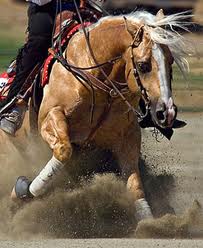|
~Reining~
About Reining - article by USEF Reining is designed to show the athletic ability of ranch type horse in the confines of a show arena. Contestants are required to run one of ten approved patterns, divided into seven or eight maneuvers, including small slow circles, large fast circles, flying lead changes, 360 degree spins done in place, and the exciting sliding stops that are the hall mark of the reining horse. Despite the seemingly relaxed attitude of both horse and rider and the loose reins typical of the discipline, Reining is a high level competition sport requiring concentration and high riding competence. Reining was approved as an FEI discipline in 2000 and covers horses of 6-years and over. The number of international competitions organised throughout the world is growing at a healthy pace: from three in 2001 the number has increased to 43 in 2008 with events organised in the United States of America and Canada, but also in Italy, France, Switzerland, Czech Republic, Israel and Brazil.
Reining originated from the moves that cattle horses adopt when on the job...It was first recognised as a sport in 1949 by the American Quarter Horse Association (AQHA), the world’s largest equestrian organisation currently counting more than 320,000 members and some four million horses. Its members, be they competitors, coaches, breeders or horse owners, greatly contributed to giving the western ranch type horse the international recognition it enjoys today. From 1966 through to 2000, the sport was managed by the National Reining Horse Association (NRHA). In 1999, it had some 9,000 members worldwide and distributed USD 3,6 in prize money to 317 competitions. On 14 April 2000, the FEI approved Reining as its seventh discipline.
Required Movements
The required movements are: •Walk-in: brings the horse from the gate to the centre of the arena to begin its pattern; should appear relaxed and confident.
•Stop: the act of slowing the horse from a lope to a stop position by bringing the hind legs under the horse in a locked position sliding on the hind feet.
•Spin: a series of 360-degree turns, executed over a stationary (inside) hind leg; location of hind quarters should be fixed at the start and maintained throughout the spin.
•Rollback: a 180-degree reversal of forward motion completed by running to a stop, turning the shoulders back to the opposite direction and departing at a canter, as a continuous motion.
•Circle: done at the lope, of designated size and speed; demonstrates control, willingness to guide and degree of difficulty in speed and speed changes.
•Hesitate: act of demonstrating horse's ability to stand in a relaxed manner at a designated time in the pattern; horse should be motionless and relaxed.
•Lead change: act of changing the leading legs of the front and rear pairs, at a lope, when changing direction.
•Run-down and Run-around: demonstrate control and gradual increase of speed to the stop.
Reining horses are judged individually. Each horse automatically begins the required pattern with a score of 70. One or ½ points are given or taken away for each manoeuvre. Credit is given for smoothness, finesse, attitude, quickness and authority. Controlled speed in the pattern raises the level of difficulty and makes the reining horse exciting to watch. All competitors wear appropriate western attire including a long sleeve shirt with collar, cowboy boots and western hat or safety helmet
Return to Horse Riding Connection
|
